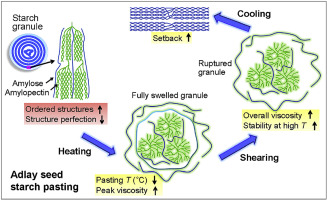当前位置:
X-MOL 学术
›
Food Hydrocoll.
›
论文详情
Our official English website, www.x-mol.net, welcomes your
feedback! (Note: you will need to create a separate account there.)
Understanding the supramolecular structures and pasting features of adlay seed starches
Food Hydrocolloids ( IF 11.0 ) Pub Date : 2018-10-01 , DOI: 10.1016/j.foodhyd.2018.05.034 Lange Miao , Siming Zhao , Binjia Zhang , Manman Tan , Meng Niu , Caihua Jia , Qilin Huang
Food Hydrocolloids ( IF 11.0 ) Pub Date : 2018-10-01 , DOI: 10.1016/j.foodhyd.2018.05.034 Lange Miao , Siming Zhao , Binjia Zhang , Manman Tan , Meng Niu , Caihua Jia , Qilin Huang

|
Abstract This work concerns the multi-scale supramolecular structures and physicochemical properties of two small adlay seed starches (Q-2 and P-6) and a big adlay seed starch (BW). Among the three starches, P-6 exhibited unique hierarchical structures and thus thermal and pasting properties. The underlying mechanism on starch property differences was discussed from a hierarchical (multi-scale) structural view. Specifically, P-6 possessed the lowest granule size, the intermediate lamellar thickness and compactness, and the highest contents of helices and crystallites with a relatively high flaw degree. These multi-scale structures were most susceptible to hydrothermal effects, eventually showing the lowest thermal transition and pasting temperatures. Also, this sample had the highest paste viscosities related to the swelling degree of starch granules and the water-holding ability of starch molecules. The shell of the fully swelled granules (granule ghosts) for P-6 were most robust under shearing and heating, resulting in the lowest breakdown viscosity (i.e., the highest paste stability during heating). The strongest assembly capacity for the starch chains of P-6, as indicated by its highest content of orders in untreated granules, induced a prominent increase in the paste viscosity during cooling. The results here indicate that P-6 may serve as functional agents such as thickeners with low pasting temperature as well as high viscosity and high paste stability under shearing and heating.
中文翻译:

理解薏苡仁淀粉的超分子结构和糊化特性
摘要 这项工作涉及两种小薏仁种子淀粉(Q-2 和 P-6)和一种大薏仁种子淀粉 (BW) 的多尺度超分子结构和理化性质。在三种淀粉中,P-6 表现出独特的层次结构,因此具有热和糊化特性。从层次(多尺度)结构的角度讨论了淀粉性质差异的潜在机制。具体而言,P-6颗粒尺寸最小,层状厚度和致密性中等,螺旋和微晶含量最高,缺陷程度相对较高。这些多尺度结构最容易受到热液效应的影响,最终显示出最低的热转变和粘贴温度。还,该样品具有与淀粉颗粒的溶胀度和淀粉分子的持水能力相关的最高糊状物粘度。P-6 的完全溶胀颗粒(颗粒重影)的外壳在剪切和加热下最坚固,导致分解粘度最低(即加热过程中糊剂稳定性最高)。P-6 淀粉链的最强组装能力,正如其在未处理颗粒中的最高有序含量所表明的那样,在冷却过程中导致糊状物粘度显着增加。这里的结果表明,P-6 可以作为功能剂,例如具有低糊化温度以及高粘度和高剪切和加热糊状物稳定性的增稠剂。P-6 的完全溶胀颗粒(颗粒重影)的外壳在剪切和加热下最坚固,导致分解粘度最低(即加热过程中糊剂稳定性最高)。P-6 淀粉链的最强组装能力,正如其在未处理颗粒中的最高有序含量所表明的那样,在冷却过程中导致糊状物粘度显着增加。这里的结果表明,P-6 可以作为功能剂,例如具有低糊化温度以及高粘度和高剪切和加热糊状物稳定性的增稠剂。P-6 的完全溶胀颗粒(颗粒重影)的外壳在剪切和加热下最坚固,导致分解粘度最低(即加热过程中糊剂稳定性最高)。P-6 淀粉链的最强组装能力,正如其在未处理颗粒中的最高有序含量所表明的那样,在冷却过程中导致糊状物粘度显着增加。这里的结果表明,P-6 可以作为功能剂,例如具有低糊化温度以及高粘度和高剪切和加热糊状物稳定性的增稠剂。正如其在未处理颗粒中的最高订单含量所表明的那样,在冷却过程中导致糊剂粘度显着增加。这里的结果表明,P-6 可以作为功能剂,例如具有低糊化温度以及高粘度和高剪切和加热糊状物稳定性的增稠剂。正如其在未处理颗粒中的最高订单含量所表明的那样,在冷却过程中导致糊剂粘度显着增加。这里的结果表明,P-6 可以作为功能剂,例如具有低糊化温度以及高粘度和高剪切和加热糊状物稳定性的增稠剂。
更新日期:2018-10-01
中文翻译:

理解薏苡仁淀粉的超分子结构和糊化特性
摘要 这项工作涉及两种小薏仁种子淀粉(Q-2 和 P-6)和一种大薏仁种子淀粉 (BW) 的多尺度超分子结构和理化性质。在三种淀粉中,P-6 表现出独特的层次结构,因此具有热和糊化特性。从层次(多尺度)结构的角度讨论了淀粉性质差异的潜在机制。具体而言,P-6颗粒尺寸最小,层状厚度和致密性中等,螺旋和微晶含量最高,缺陷程度相对较高。这些多尺度结构最容易受到热液效应的影响,最终显示出最低的热转变和粘贴温度。还,该样品具有与淀粉颗粒的溶胀度和淀粉分子的持水能力相关的最高糊状物粘度。P-6 的完全溶胀颗粒(颗粒重影)的外壳在剪切和加热下最坚固,导致分解粘度最低(即加热过程中糊剂稳定性最高)。P-6 淀粉链的最强组装能力,正如其在未处理颗粒中的最高有序含量所表明的那样,在冷却过程中导致糊状物粘度显着增加。这里的结果表明,P-6 可以作为功能剂,例如具有低糊化温度以及高粘度和高剪切和加热糊状物稳定性的增稠剂。P-6 的完全溶胀颗粒(颗粒重影)的外壳在剪切和加热下最坚固,导致分解粘度最低(即加热过程中糊剂稳定性最高)。P-6 淀粉链的最强组装能力,正如其在未处理颗粒中的最高有序含量所表明的那样,在冷却过程中导致糊状物粘度显着增加。这里的结果表明,P-6 可以作为功能剂,例如具有低糊化温度以及高粘度和高剪切和加热糊状物稳定性的增稠剂。P-6 的完全溶胀颗粒(颗粒重影)的外壳在剪切和加热下最坚固,导致分解粘度最低(即加热过程中糊剂稳定性最高)。P-6 淀粉链的最强组装能力,正如其在未处理颗粒中的最高有序含量所表明的那样,在冷却过程中导致糊状物粘度显着增加。这里的结果表明,P-6 可以作为功能剂,例如具有低糊化温度以及高粘度和高剪切和加热糊状物稳定性的增稠剂。正如其在未处理颗粒中的最高订单含量所表明的那样,在冷却过程中导致糊剂粘度显着增加。这里的结果表明,P-6 可以作为功能剂,例如具有低糊化温度以及高粘度和高剪切和加热糊状物稳定性的增稠剂。正如其在未处理颗粒中的最高订单含量所表明的那样,在冷却过程中导致糊剂粘度显着增加。这里的结果表明,P-6 可以作为功能剂,例如具有低糊化温度以及高粘度和高剪切和加热糊状物稳定性的增稠剂。











































 京公网安备 11010802027423号
京公网安备 11010802027423号